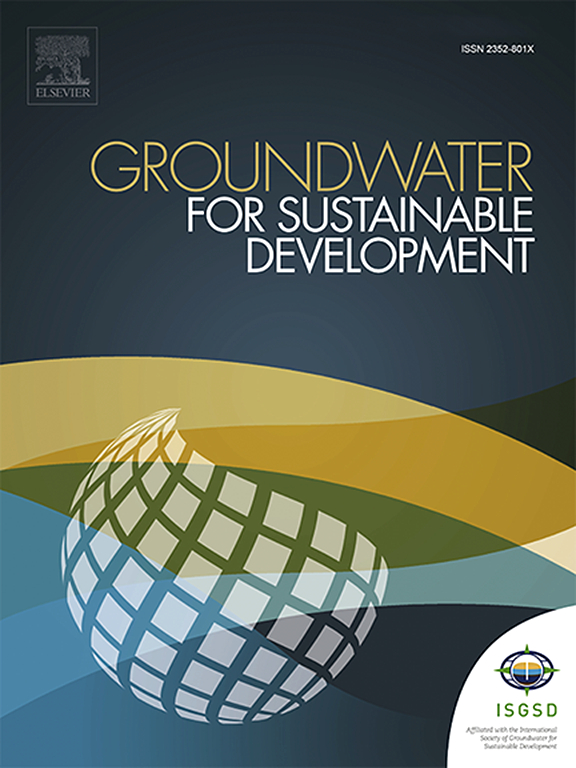Unveiling groundwater gems: A GIS-powered fusion of AHP and TOPSIS for mapping groundwater potential zones
IF 4.9
Q2 ENGINEERING, ENVIRONMENTAL
引用次数: 0
Abstract
Groundwater is indispensable to various sectors like industry, households, and agriculture, yet its assessment remains critical. This research focuses on evaluating potential groundwater zones within the Jamsholaghat watershed, employing a robust geospatial approach. Twelve thematic maps, spanning factors influencing groundwater recharge, namely lithology, drainage density, distance from river, land use and land cover, lineament density, rainfall, hydrological soil group, roughness, geomorphology, topographic position index, slope, and topographic wetness index underwent a multicollinearity check for independence before integration using ArcGIS's weighted overlay analysis. Utilizing a combination of the Technique for Order Preference by Similarity to the Ideal Solution (TOPSIS) and the Analytical Hierarchy Process (AHP), each thematic map was ranked based on its relative significance in groundwater recharge. The resulting Groundwater Potential Zone (GPZ) map divided the region into high (40%), medium (52%), and low (8%) potential zones. Notably, the easternmost part emerged as the most conducive for recharge, attributed to factors like favorable lithology (laterite and quartz), geomorphological features (water bodies and flood plains), high rainfall, and gentle slope. This insight can inform targeted interventions for sustainable groundwater management. This practical information empowers water resource managers to prioritize exploration efforts. By focusing drilling activities on high-potential zones, success rates can increase, saving time, money, and minimizing environmental impact. Furthermore, understanding recharge-influencing factors can guide land-use practices that promote infiltration, ensuring the long-term sustainability of this vital resource. This research paves the way for informed decision-making, fostering sustainable groundwater management practices within the Jamsholaghat watershed.

揭开地下水的宝石:一个gis驱动的AHP和TOPSIS的融合,用于绘制地下水潜在区
地下水对工业、家庭和农业等各个部门都是不可或缺的,但对地下水的评估仍然至关重要。本研究的重点是评估Jamsholaghat流域内潜在的地下水带,采用了一种强大的地理空间方法。12张专题图,包括影响地下水补给的因素,即岩性、排水密度、与河流的距离、土地利用和土地覆盖、地形密度、降雨量、水文土壤类型、粗糙度、地貌、地形位置指数、坡度和地形湿度指数,在使用ArcGIS加权叠加分析进行整合之前,对其进行多重共线性独立性检验。利用TOPSIS (Order Preference by Similarity by the Ideal Solution)和AHP (Analytical Hierarchy Process)相结合的方法,根据各专题地图在地下水补给中的相对重要性对其进行排序。由此产生的地下水潜力带(GPZ)图将该地区划分为高(40%)、中(52%)和低(8%)潜力区。值得注意的是,由于有利的岩性(红土和石英)、地貌特征(水体和洪泛平原)、高降雨量和平缓的坡度等因素,最东端最有利于补给。这一见解可以为可持续地下水管理提供有针对性的干预措施。这些实用的信息使水资源管理者能够优先考虑勘探工作。通过将钻井活动集中在高潜力区域,可以提高成功率,节省时间和金钱,并最大限度地减少对环境的影响。此外,了解补给影响因素可以指导促进入渗的土地利用实践,确保这一重要资源的长期可持续性。这项研究为知情决策铺平了道路,促进了Jamsholaghat流域内可持续的地下水管理实践。
本文章由计算机程序翻译,如有差异,请以英文原文为准。
求助全文
约1分钟内获得全文
求助全文
来源期刊

Groundwater for Sustainable Development
Social Sciences-Geography, Planning and Development
CiteScore
11.50
自引率
10.20%
发文量
152
期刊介绍:
Groundwater for Sustainable Development is directed to different stakeholders and professionals, including government and non-governmental organizations, international funding agencies, universities, public water institutions, public health and other public/private sector professionals, and other relevant institutions. It is aimed at professionals, academics and students in the fields of disciplines such as: groundwater and its connection to surface hydrology and environment, soil sciences, engineering, ecology, microbiology, atmospheric sciences, analytical chemistry, hydro-engineering, water technology, environmental ethics, economics, public health, policy, as well as social sciences, legal disciplines, or any other area connected with water issues. The objectives of this journal are to facilitate: • The improvement of effective and sustainable management of water resources across the globe. • The improvement of human access to groundwater resources in adequate quantity and good quality. • The meeting of the increasing demand for drinking and irrigation water needed for food security to contribute to a social and economically sound human development. • The creation of a global inter- and multidisciplinary platform and forum to improve our understanding of groundwater resources and to advocate their effective and sustainable management and protection against contamination. • Interdisciplinary information exchange and to stimulate scientific research in the fields of groundwater related sciences and social and health sciences required to achieve the United Nations Millennium Development Goals for sustainable development.
 求助内容:
求助内容: 应助结果提醒方式:
应助结果提醒方式:


